It's no secret that curtains are able to visually ennoble the interior of any room in a home. With them, the windows become smart, and the design becomes sophisticated. When it comes to choosing models for the kitchen, the average person often thinks that it is almost impossible to find something practical and beautiful for her. The material in this article will prove the opposite: we will introduce the reader to the peculiarities of the choice of such curtains, and put on the shelves the main aspects, including the types of curtains in the kitchen, their design options, color schemes and design.






Features
Curtains for the kitchen are interior accessories, they carry practical and decorative loads. On the one hand, these are elements of window decor, on the other, a way of protection from sunlight. They give completeness to any interior, saving windows from loneliness. Moreover, if necessary, they are ready to hide what is happening inside from the curious human views from the street.
Few people thought that curtains in the kitchen can be a way to visually increase the space. In Soviet-style houses, kitchen windows are often small, which causes significant damage to the interior of these rooms. Curtains are able to visually increase the size of window openings with the right approach to their choice. In addition, these are excellent accents of the interior, which can indicate its belonging to one or another style of interior design.




Today they are highlighted in a special line of curtains offered for decorating window openings in kitchens.
From typical curtains for other rooms of the home, they can be distinguished design, cut type, design method, length, coloring. Often they do not tolerate excessive pomposity and pretentiousness. This is good for kitchens, because here usually there are a lot of small things that make an illusion of disorder.
Models for the kitchen are different, depending on the type of room and the location of the elements of furniture. Curtains can be the same for all windows or different in length, depending on the location and type of windows. For example, models for windows near which the sink is located are always short. Analogs for guest zones are often long, although they are subject to user safety rules.




Unlike curtains for other rooms, they do not have floor lengths and unnecessarily complicated draperies.
They should not interfere with being located in any area of the kitchen or sitting in places, clinging to the dining / working table or to the feet of the household. In a word, these are curtains that buy, based not only on beauty, but also on practicality in the kitchen. Their task is to unobtrusively emphasize the integrity of interior design.
They are also subject to other requirements, for example, they must:
- not to impede access to the window for ventilation;
- do not absorb odors and particles of food;
- match the interior textiles and its color scheme;
- look modern and stylish with seeming simplicity;
- provide for easy cleaning or washing;
- made from quality materials.
In addition, they should not be loose or tangled.






Kinds
The times when exceptionally simple crocodile curtains hung on kitchen windows sank into oblivion. Today, in the lines of manufacturers of these products, you can find a lot of options of various cuts and shapes that are perfect for decorating a window opening. At the same time, kitchen curtains can be very different:
- symmetric and asymmetric;
- single and double;
- from one material and combined;
- light and heavy;
- plain and printed, with a pattern or photo printing;
- concise and creative;
- unilateral and bilateral;
- with manual or mechanical way of opening and closing;
- on the entire wall, window or several shutters of your choice;
- day or night.
The choice of the right option is based on the resource of a particular style of interior design.
That is why unsuitable, it would seem, curtains in the end look on the windows not only harmoniously, but also spectacularly. And therefore, taking them without reference to a specific style is simply useless.




This violates the selection rule, because each interior style has its own priorities in choosing the material, color, cut and style of kitchen curtains. For example, some models are designed in the style of the French hinterland, others are suitable specifically for panoramic windows of industrial style.
Still others gravitate towards the palace solemnity of the classical style. Others are laconic and designed for a modern style. However, they are just perfectly combined with most varieties of curtains up to the tulle, forming together a harmonious design of the kitchen windows.
Consider several varieties of curtains for the kitchen, which are more able to become an adornment of the interior of a particular design. The main thing is to look at them with a designer look.

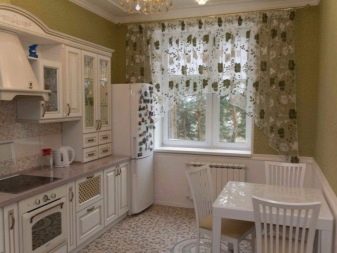
On grommets
These models are today considered one of the universal. Many people like them for their laconicism and a certain elegance due to the presence of metal rings, through which they are worn on a cornice. In terms of design, these curtains are unique: with the usual rectangular shape and light tails, they look elegant in any interior style. At the same time, the models can be a single canvas on the window or paired curtains, which can be fixed with hooks, if this is conceived by design. Often the upper part of these products is decorated with a special pattern.
The textile and density of such curtains can be very diverse (from a veil to velvet).
Models may include asymmetric design and even cut, they can be hung on the sides of the tulle with identical eyelets. However, with all the desire, they should not be hung with the smell of one curtain on another. But you can compensate for the shortcoming by means of the upper frill, ordering a model with it.






On hinges and clothespins
These models, in fact, are an alternative to grommets. They have the same shape and cut. They are also concise and can decorate the interior of the kitchen without diminishing the practicality and functionality. However, the options on the hinges are not so universal: they are designed more likely for a rustic style (for example, Provence).
Appropriate in the interior of the kitchen of a country house or even a summer residence.
Analogs on clothespins in this regard are more universal. They can be hung and decorated in different ways: symmetrically, asymmetrically, with pickups, with the entry of one canvas to another. They look beautiful in the interior, can decorate windows and modern design directions, and retro styles. They are made mainly from loose and light material.





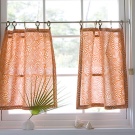
Curtain Cafe
A beautiful name means curtains of short length that do not reach the windowsill. Usually they are hung in the middle of the window on a transverse bar, which is why they only partially cover it. In other varieties, fastening is carried out inside the frame almost at the glass sheet, often supplementing the curtains with an upper frill.
Depending on the design, the frill is attached to its cornice by means of a drawstring or crocodiles. Other upper elements are attached to special Velcro for molding.
The shape of these curtains is often rectangular. They can be a single frill with soft folds, barely reaching the length of the window frame, or a pair of curtains, which can be moved apart in different directions, if necessary.
Often the cut of the curtain cafe is complemented by wide edging, frills and ruffles, pickups, ribbons. These models are suitable mainly for retro interiors, country and French backwoods style. In modern style, they are inappropriate.






With lambrequin
Despite the seeming inappropriateness, these curtains can become a worthy decorative element in the arrangement of the kitchen-living room. However, you need to choose the right model: do not bet on a complex type of lambrequin. Layering and deliberate pomposity have long gone out of fashion. It is necessary to select options with the dosage form and type of design.
For instance, in fashion, not so much a model with swag as a product with a rigid form of a lambrequin. Well, if it is decorated with perforation, arched form and some kind of ornament.
This hints at a certain style, the pattern can be used as an element of textile support in the interior of a particular kitchen.
Such curtains are made of material of different density, they can be symmetric and asymmetric, as well as combined. But if you want to use two contrasting materials to decorate kitchen windows, you need to do this with a dosage of swag and full.






Austrian
Viennese curtains are unique not only in appearance, but also in the way of transformation. In essence, this a rectangular canvas with a lifting mechanism and often an electric drive, whereby it is collected in draped festoons. From curtains for other rooms, these products differ in the number of festoons and the material of manufacture. For example, they can be made of natural textile with the number of festoons from 1-3 to 5.
These varieties are suitable for decorating the windows of kitchens of a classical style; they are appropriate in modern and ethnic stylistics.
More often, these models differ in length to the windowsill and above, which allows you to complement them with curtains of laconic cut. Often they barely close half the window, complemented by a lambrequin. These models look most beautiful in the dining or even living area of the kitchen.






French
These models are often confused with Austrian counterparts. Outwardly, they are really similar, they look like draped festoons. They are made of elastic and pliable material, however, if the Austrian curtains are collected in scallops only at the bottom, the French are sewn along the entire length.
At the same time, they are equipped with a lifting mechanism, by means of which the height of the panel is adjusted.
Thus, they can be made lush or undulating. Unlike Austrian versions, French curtains are lowered in a semicircle. Visually, they do not break up into separate semicircular segments. Their cut is simpler than Austrian, they are technically universal for any interior. They are sewn more often from thin and translucent matter.



English
English curtains are another type of curtain type lifting. Their basis is a canvas of rectangular shape, due to rings with cords installed vertically from the wrong side, they are raised to the desired height. However, as a rule, they do not have such lush folds and draperies as the French and Austrian varieties.
Lifting cords of curtains can be located on the edges of the panel. Install these models on a profile cornice with an open or closed lifting mechanism.
Such products can decorate not only ordinary, but also arched and bay windows of the kitchen. In this case, the cornice can be attached not only to the ceiling, but also to the slope of the window or window frame. If you choose the right fabric, decoration and design, these models are suitable for any style of interior.






Japanese panels
These models on the kitchen windows look not only unusual, but also stylish and creative. They look like sheets of paper, are stretched and do not change shape even with a draft. These are excellent models, often up to the windowsill, which are convenient for use and can be made of different materials.
The design of the screen curtains consists of a retaining element located in the upper part, a base and a weighting agent.
In operation, they are light and comfortable. These are wearproof curtains with a moving panel control system. They move according to the screen principle, while the width of the section in some cases can reach 1 m. Unlike many other varieties, not only natural textiles, but also bamboo can be used in the production of Japanese panels.






Greek
These curtains are sewn more often from dense textiles (coarse cloth, wool). They look simple, which allows you to refresh them with all kinds of laces and tassels. Models can be hung through various fasteners.
The basic difference of these products is the presence of an original antique pattern in the form of a geometric or natural ornament.
They are characterized by strict forms, the naturalness of the textiles used, sometimes a wealth of accessories. Greek curtains are always paired, they are hung symmetrically, they are able to decorate the interior of a kitchen of different sizes and degrees of illumination. The products are easy to care for, they are easy to make at home with your own hands.


Rolshtora
These lifting curtains are truly unique: they are short, barely close the window, look like a straight sheet and, when closed, are rolled up onto a special shaft. They can have a different type of transformation and mounting. For instance, the closer they are attached to the glass, the denser they fit. Some of them have a cassette into which, when opened, the textile is folded.
The second modifications are better because the cartridge protects the material from dust, and they look more aesthetically pleasing in the interior.
If desired, they can decorate the window only partially (certain of its wings). Models can be single, in addition, 2 cartridges can be mounted on one window, opening one of them up and the other down. The blinds are mounted on top of the frame or inside it; the color of the cassette may be the same as the color of the window frame.



Roman
These curtains are often confused with roller blinds, however they have a different way of closing. If roller mechanisms provide for winding material onto a shaft, Roman analogues have a folding type, something similar to blinds. At the same time, they gather in a series of wide folds of identical size and shape. They can be folded both fully and partially, which allows you to vary the degree of illumination of the kitchen at the request of the owners of the house.
Models can be decorated with edging around the entire perimeter, some of them provide for the replacement of textiles or repair.
They are great for kitchens, whose washing is located under the window. Roman curtains are compact, look stylish, can be plain and printed, have a rail and an adjusting cord. To maintain an even shape below equipped with a weighting agent. They are suitable for any style of interior, as they can be combined with universal curtains and tulle.






Accordion pleats
These models belong to the variants of the modern shortened type. They look great on the windows of kitchens, are suitable even for small window openings and can be harmoniously combined with curtains from different materials. The design of the curtains is a rectangular textile, gathered in folds on the principle of accordion. Often these models are erroneously called Roman, although they have differences.
The main difference lies in the fact that they have a strictly regulated width of folds, which cannot exceed 5 cm.
These are not blinds, but a separate line of curtains, which are made mainly from natural raw materials. They are expensive, they can decorate kitchen windows of various shapes, including variants of complex geometry (for example, arched, trapezoidal, round). Roman counterparts gather in folds on the sides and can not boast of this ability, unlike accordion pleats.

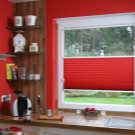


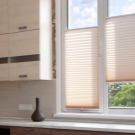
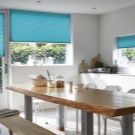
Nightly
These products can have different shapes and designs. These are curtains, blinds, double, Roman, roller blinds and even photocurtains. Depending on the variety, models are mounted on grommets, rings, loops, and a shaft.
In fact, these are curtains of any type made of special textiles, which, on the one hand, let light into the room, and on the other, reliably protect the whole kitchen from prying eyes from the street. The textiles of these curtains are dense, their length is more often standard, which is why they are used more for the guest part of the kitchen-living room.






Materials
Usually, when choosing a fabric, the buyer tries to give preference to a practical material that is undemanding in care. The main problem for curtains is spray, greasy stains, soot and specific odors. For this reason, the buyer is trying to choose those materials that will be easy to wash and iron. The correct type of fabric is easier to wash, does not lose shape and color, and has dust-repellent properties.
In the manufacture of curtains for kitchens, brands use a wide variety of materials.

Among the most popular raw materials it is worth noting linen, chintz, silk, satin, nylon, viscose, acetate, polyester, synthetic organza, bamboo and plastic. As for dense materials, they are quite specific and do not always look harmoniously in the arrangement of kitchens. However, when choosing one or another textile, you need to consider the style of interior design.
Linen, cotton, silk and satin curtains with the right choice of model are appropriate not only in the styles of country, boho, retro and provence, but also in the classical stylegravitating to everything elegant. The materials are environmentally friendly, hypoallergenic, transmit air and light. However, in addition to the high cost, they are not all machine washable. And also curtains made from natural textiles (especially cotton and linen) are unstable to fading, as well as to some detergents.


They wear out and lose attractiveness faster than analogues made of mixed fibers.
Analogs from synthetic fabrics are more affordable and less expensive.They are durable, wear-resistant, do not wrinkle, do not sit down during washing, and do not fade. However, they attract dust and are electrified.
Bamboo and plastic curtains attract attention. At the same time, the former can be used in arranging the styles of shabby chic, country, Provence, oriental stylistics, while the latter will look good in modern design kitchens.
Textiles for kitchen windows are characterized by density and type of weaving of threads.

It can be airy and dense, and sometimes rough.
Today on sale you can find curtains for kitchens:
- nylon;
- satin;
- velvet
- from matting;
- tape
- lacy;
- blackout;
- from reaper;
- from burlap.
Someone acquires a veil and muslin for the design of kitchen windows. However, it is difficult to call Kisei a suitable material for decorating kitchen windows. Filament curtains can cling to anything, they get confused during operation. They look beautiful only in pictures.



Colors and prints
Color schemes and design of kitchen curtains are subject to different selection criteria. Among the main points, it is worth noting the priorities of color solutions for a particular style. Let's say Provence for style is light pastel and whitened tones. Are appropriate here white, light mint, pinkish, pale blue, whitish-lavender, pistachio, pearl, creamy, milky, beige. A combination of beige with blue, white, lavender, pistachio, pale turquoise color is welcome.
Traditional prints of this style - light motifs of a flower meadow, simple and medium-sized flowers, as well as a cage, medium-sized strip, sometimes flowers in stripes and polka dots. And striped, and checkered, and floral pattern should be made in muted colors, nothing sharp and acid is allowed.






The atmosphere in the room is created somewhat romantic, which should be reflected in the choice of pattern and color. Curtains need to be selected in such a way that an abundance of light is felt.
Country already needs brightness - despite the light background of the curtains, drawings on them may be more saturated. The same applies to the decoration of curtains: edging, ruffles, decorative braid, frills can also be bright. It is important to select models with such a condition that they reflect the identity of the village house. The style is close to nature, the curtains should be made of natural material, and their pattern should reflect the characteristic ethnic features of a particular place.
As already mentioned the background of the curtains should be light, it is important to create the illusion of light and heat. The prints here can be different, for example, striped, floral and floral, variegated. When you want to choose curtains for the Gzhel style, the choice is obvious. Here you need the basic colors of the style (white and bright cornflower blue), while the drawings may be different (for example, dishes, teapots, flowers, ornaments, floral motifs, white peas on a cornflower background) The curtains here are certainly two-tone, the infusion of other tones of the palette is not allowed.


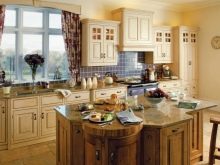
Classical design trends (classic, neoclassic, baroque) cannot be without a demonstration of palace solemnity, and therefore the colors here can be both gentle and bright.
Dosing their elegance, you can choose models from plain fabrics with contrasting gilded trim (for example, braid with brushes or fringe, pickups). In addition, all sorts of monograms belong to this style, which can be taken as a basis when choosing a print for curtains. But if this picture is already on the wallpaper, it is better to take curtains in plain colors.
Contemporary style (e.g. minimalism, hi-tech, brutalism, loft, grunge, fusion) can use as neutral paints (white, gray, black) both color. Designers consider beige, creamy, white, pink-violet, pistachio, brick, lemon, gray, gray-beige, wine, muted orange tones the best tones of the color palette today.



As for prints, somewhere these are discreet flowers, somewhere floral motifs, leaves, sometimes a marine pattern, as well as ornaments in which plants are intertwined with monograms, polka dots with a cage.
Sometimes prints are indicated by the texture of the material (for example, it can be a dense pattern on a translucent background, like openwork curtains).
In fashion and curtains with photo printing. At the same time, the print is often applied to canvases of a rectangular shape with a simple cut, so that in the evening, closing the curtains, immerse the room in a special atmosphere. Depending on the style of design, this can be a floral theme or a drawing of a night city drowning in the lights of lanterns. Someone chooses models with fruit prints, others like landscapes, still lifes, coffee themes, plants, hieroglyphs.
In some areas of design, prints are not needed at all.

Design options
The design of curtains can be the most diverse - from simple rectangular canvases to creative models. Curtains in the kitchen can be:
- concise rectangular without decor;
- paired rectangular with pickup on one side;
- asymmetric rectangular with a cut of the cloth along the oblique;
- with drapery in the form of a cascade, a semicircle;
- with soft or hard pelmet and laconic curtain;
- with a lambrequin, swagas or peroxides and short oblique curtains;
- combined in the form of a duet of short modern curtains and light curtains;
- short double tulle arched or semi-arched type;
- exclusive, custom-made according to an individual sketch;
- original with unusual decorative elements, pickups or clamps.
As for decorative elements, even laconic products can have different decor.
Thanks to this, they look different and can be used in different kitchen interiors.
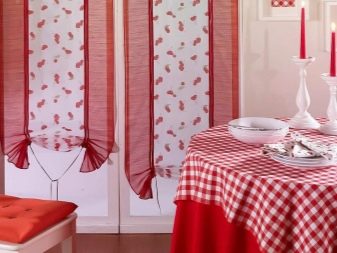



For example, the same cafe models may have ruffles at the top, and a wide contrasting strip and ornament on a certain topic below.
Other models are decorated not only with ruffles, but also with beautiful fringe with tassels, frills, embroidery, perforation, beads. Craftswomen sew interesting curtain patterns, decorating them around the edges with knitted braid, pompons. Decoration can be contrasting colors, jabot, tie, garter, magnetic tape, bow.

Calculate the length
The length of the curtains for kitchen windows depends on their variety. For example, if it is roller blinds (roller blinds), it is selected in two ways based on the type of mount. If they are mounted in front of the frame, the length should correspond to the height from the cornice to the windowsill. When they are fixed near the glasses, they are guided by the length and width of the glasses. To calculate the length of the curtains, measure the distance from the cornice or place of attachment.
For example, from the ceiling cornice, window opening, the middle of the window to the point where the curtain should end. It can end at the windowsill, just below it, as well as 3-4 cm above the floor.
For example, if you need classic curtains from the ceiling with a wall height of 2.47 m, then their length will be 247 cm - 4 cm = 243 cm. To prevent the curtains from touching the window sill, their length should be 1 cm higher. When the length is lower than the window sill, then it is measured no more than 10-15 cm.


How to arrange?
The arrangement of kitchen curtains can be different, depending on the type of fastening. For example, if:
- fasten the cornice on the wall, curtains will close the frame;
- fix them inside the frame almost at the glass; they cover only the glass;
- need to visually increase the size of the window, curtains are hung on the entire wall;
- these are bay windows, they are mounted on a cornice with bends.
On sale today you can find mini-cornices that are great for plastic windows. In addition to them, cornices can be rod, telescopic, string, profile, baguette, spacer. You can position the curtains symmetrically, asymmetrically, draping matter.



To open the matter, you need to hang the curtains so that they start about 10 cm above the window frame.This rule also applies to round windows.
Straight curtains for arched windows can begin below the round dome. If the windows are triangular, here you will have to use 2 cornices with the formation of an angle flush with the peak shape. The fabric can be overlapped, it can also be a solid triangular canvas fixed by means of holders, or sliding trapezoidal curtains.
Attic windows are sloping; different types of curtains look good on them. However, they will have to be fixed not only at the top, but also at the bottom. If possible, you can use horizontal shutters that hide the opening and do not fall on the wall space. Japanese panels and blinds, equipped with clamps and weighting materials, are ideally suited for such windows.

Bay windows can be decorated with a whole curtain composition. These curtains are fixed at the junction with the walls, often emphasizing the upper part with a lambrequin.
When the joints are large, each of them can be beaten with curtains, creating the illusion of separate windows. If the partitions are small, for these sections of the wall it is enough to take matter of a darker color.
Corner windows need to emphasize exactly the corner. You can make the corner an accent of the curtain composition, here you can hang the curtains collected in the middle. However, their length may be shorter than the main curtains. It is necessary to arrange curtains on such windows by means of eaves connected at the joints. These are not flexible profiles used for bay windows, and not separate sticks.


Selection tips
Having dealt with the varieties and materials of curtains for the kitchen, you can go to the store. And before that, it is worth arming yourself with the valuable advice of specialists.
- Decide on the type of curtains based on the features of the interior. Choose a form based on the interior composition of your kitchen.
- The color scheme should be in tune: you need curtains in a single color key.
- Pay attention to the type of mount, Decide how you want to hang the curtains (on the ceiling cornice, Velcro, wall cornice, open, closed).
- Pay attention to the interior: the higher his pretentiousness, the higher the status of the models.
- The architecture of the room also matters.: simple models are taken to an ordinary apartment with a simple interior. Special ones are selected for the bay window.
- The accounting of usable area is important: the smaller it is, the simpler the design. For small kitchens, short curtains such as rolshtor, pleated, Roman are needed.
- If curtains are taken to hide the room from the sun, the type of material must be opaque.
- Cozy curtains - those that do not get out of the general concept of style do not interrupt attention, but are harmonious with each element of the arrangement.
- Patterned Curtains suitable for interior decoration when there is not much print in it. Multicolor is able to simplify even the exquisite style.
- Long curtains good in kitchens, short ones are more suitable for a working area.

Window Design Guidelines
To design kitchen windows with curtains can be different:
- hanging one canvas with folds on each window;
- hanging paired curtains with symmetrical pickups;
- throwing over the cornice for the formation of festoons;
- fixing in the middle with an hourglass tie;
- hanging with an overlap with the entry of one panel to another;
- collecting curtains with bows or voluminous elastic bands for hair;
- using accent decor (for example, curtain beetles and butterflies);
- collecting in the middle with the help of special decorative pins;
- without touching one side and draping the second.
Design ideas depend on a flight of fancy and a design approach. Curtains designed with these criteria in mind will look stylish and effective in the interior of any kitchen.
How to choose curtains in the kitchen, see below.










